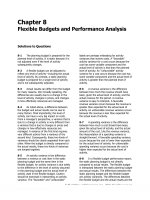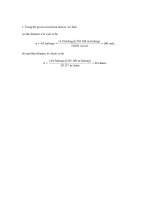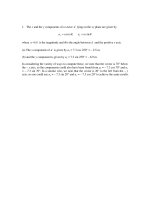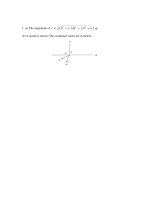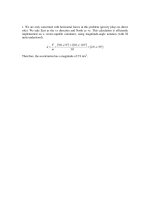Solution manual vector mechanics engineers dynamics 8th beer chapter 08
Bạn đang xem bản rút gọn của tài liệu. Xem và tải ngay bản đầy đủ của tài liệu tại đây (6.45 MB, 149 trang )
COSMOS: Complete Online Solutions Manual Organization System
Chapter 8, Solution 1.
FBD Block B:
Tension in cord is equal to W A = 25 lb from FBD’s of block A and
pulley.
ΣFy = 0:
N − WB cos 30° = 0,
N = WB cos 30°
(a) For smallest WB , slip impends up the incline, and
F = µ s N = 0.35WB cos30°
ΣFx = 0:
F − 25 lb + WB sin 30° = 0
( 0.35cos30° + sin 30° )WB = 25 lb
WB min = 31.1 lb
(b) For largest WB , slip impends down the incline, and
F = − µ s N = − 0.35 WB cos30°
ΣFx = 0:
Fs + WB sin 30° − 25 lb = 0
( sin 30° − 0.35cos30° )WB = 25 lb
W B max = 127.0 lb
Vector Mechanics for Engineers: Statics and Dynamics, 8/e, Ferdinand P. Beer, E. Russell Johnston, Jr.,
Elliot R. Eisenberg, William E. Clausen, David Mazurek, Phillip J. Cornwell
© 2007 The McGraw-Hill Companies.
COSMOS: Complete Online Solutions Manual Organization System
Chapter 8, Solution 2.
FBD Block B:
Tension in cord is equal to WA = 40 lb from FBD’s of block A and
pulley.
(a)
ΣFy = 0:
N − ( 52 lb ) cos 25° = 0,
N = 47.128 lb
Fmax = µ s N = 0.35 ( 47.128 lb ) = 16.495 lb
ΣFx = 0:
Feq − 40 lb + ( 52 lb ) sin 25° = 0
So, for equilibrium, Feq = 18.024 lb
Since Feq > Fmax , the block must slip (up since F > 0)
∴ There is no equilibrium
(b) With slip,
F = µk N = 0.25 ( 47.128 lb )
F = 11.78 lb
Vector Mechanics for Engineers: Statics and Dynamics, 8/e, Ferdinand P. Beer, E. Russell Johnston, Jr.,
Elliot R. Eisenberg, William E. Clausen, David Mazurek, Phillip J. Cornwell
© 2007 The McGraw-Hill Companies.
35°
COSMOS: Complete Online Solutions Manual Organization System
Chapter 8, Solution 3.
FBD Block:
Tension in cord is equal to P = 40 N, from FBD of pulley.
(
)
W = (10 kg ) 9.81 m/s 2 = 98.1 N
ΣF y = 0 :
N − (98.1 N ) cos 20° + (40 N ) sin 20° = 0
N = 78.503 N
Fmax = µ s N = ( 0.30 )( 78.503 N ) = 23.551 N
For equilibrium:
ΣFx = 0:
( 40 N ) cos 20° − ( 98.1 N ) sin 20° − F = 0
Feq = 4.0355 N < Fmax ,
F = Feq
Vector Mechanics for Engineers: Statics and Dynamics, 8/e, Ferdinand P. Beer, E. Russell Johnston, Jr.,
Elliot R. Eisenberg, William E. Clausen, David Mazurek, Phillip J. Cornwell
© 2007 The McGraw-Hill Companies.
∴ Equilibrium exists
F = 4.04 N
20°
COSMOS: Complete Online Solutions Manual Organization System
Chapter 8, Solution 4.
Tension in cord is equal to P = 62.5 N, from FBD of pulley.
(
)
W = (10 kg ) 9.81 m/s 2 = 98.1 N
ΣFy = 0:
N − ( 98.1 N ) cos 20° + ( 62.5 N ) sin15° = 0
N = 76.008 N
Fmax = µ s N = ( 0.30 )( 76.008 N ) = 22.802 N
For equilibrium:
ΣFx = 0:
( 62.5 N ) cos15° − ( 98.1 N ) sin 20° − F = 0
Feq = 26.818 N > Fmax
so no equilibrium,
and block slides up the incline
Fslip = µ x N = ( 0.25 )( 76.008 N ) = 19.00 N
F = 19.00 N
Vector Mechanics for Engineers: Statics and Dynamics, 8/e, Ferdinand P. Beer, E. Russell Johnston, Jr.,
Elliot R. Eisenberg, William E. Clausen, David Mazurek, Phillip J. Cornwell
© 2007 The McGraw-Hill Companies.
20°
COSMOS: Complete Online Solutions Manual Organization System
Chapter 8, Solution 5.
Tension in cord is equal to P from FBD of pulley.
(
)
W = (10 kg ) 9.81 m/s 2 = 98.1 N
ΣFy = 0:
N − ( 98.1 N ) cos 20° + P sin 25° = 0
(1)
ΣFx = 0:
P cos 25° − ( 98.1 N ) sin 20° + F = 0
(2)
For impending slip down the incline, F = µ s N = 0.3 N and solving
(1) and (2),
PD = 7.56 N
For impending slip up the incline, F = − µ s N = − 0.3 N and solving
(1) and (2),
PU = 59.2 N
so, for equilibrium
Vector Mechanics for Engineers: Statics and Dynamics, 8/e, Ferdinand P. Beer, E. Russell Johnston, Jr.,
Elliot R. Eisenberg, William E. Clausen, David Mazurek, Phillip J. Cornwell
© 2007 The McGraw-Hill Companies.
7.56 N ≤ P ≤ 59.2 N
COSMOS: Complete Online Solutions Manual Organization System
Chapter 8, Solution 6.
FBD Block:
(
)
W = ( 20 kg ) 9.81 m/s 2 = 196.2 N
For θ min motion will impend up the incline, so F is downward and
F = µs N
ΣFy = 0:
ΣFx = 0:
(1) + ( 2 ):
N − ( 220 N ) sin θ − (196.2 N ) cos 35° = 0
F = µ s N = 0.3 ( 220 sin θ + 196.2 cos 35° ) N
(1)
( 220 N ) cosθ
(2)
− F − (196.2 N ) sin 35° = 0
0.3 ( 220 sin θ + 196.2cosθ ) N
= ( 220 cosθ ) N − (196.2sin 35° ) N
or
220cosθ − 66sin θ = 160.751
Solving numerically:
Vector Mechanics for Engineers: Statics and Dynamics, 8/e, Ferdinand P. Beer, E. Russell Johnston, Jr.,
Elliot R. Eisenberg, William E. Clausen, David Mazurek, Phillip J. Cornwell
© 2007 The McGraw-Hill Companies.
θ = 28.9°
COSMOS: Complete Online Solutions Manual Organization System
Chapter 8, Solution 7.
FBD Block:
For Pmin motion will impend down the incline, and the reaction force R
will make the angle
φ s = tan −1 µ s = tan −1 ( 0.35 ) = 19.2900°
with the normal, as shown.
Note, for minimum P, P must be ⊥ to R, i.e. β = φs (angle between
P and x equals angle between R and normal).
β = 19.29°
(b)
then P = (160 N ) cos ( β + 40° )
= (160 N ) cos 59.29° = 81.71 N
(a)
Vector Mechanics for Engineers: Statics and Dynamics, 8/e, Ferdinand P. Beer, E. Russell Johnston, Jr.,
Elliot R. Eisenberg, William E. Clausen, David Mazurek, Phillip J. Cornwell
© 2007 The McGraw-Hill Companies.
Pmin = 81.7 N
COSMOS: Complete Online Solutions Manual Organization System
Chapter 8, Solution 8.
FBD block (impending motion
downward)
φ s = tan −1 µ s = tan −1 ( 0.25 ) = 14.036°
(a) Note: For minimum P,
P⊥R
So
β = α = 90° − ( 30° + 14.036° ) = 45.964°
and
P = ( 30 lb ) sin α = ( 30 lb ) sin ( 45.964° ) = 21.567 lb
P = 21.6 lb
(b)
Vector Mechanics for Engineers: Statics and Dynamics, 8/e, Ferdinand P. Beer, E. Russell Johnston, Jr.,
Elliot R. Eisenberg, William E. Clausen, David Mazurek, Phillip J. Cornwell
© 2007 The McGraw-Hill Companies.
β = 46.0°
COSMOS: Complete Online Solutions Manual Organization System
Chapter 8, Solution 9.
FBD Block:
For impending motion. φ s = tan −1 µ s = tan −1 ( 0.40 )
φ s = 21.801°
Note β1,2 = θ1,2 − φ s
10 lb
15 lb
=
sinφs sinβ1,2
From force triangle:
15 lb
33.854°
sin ( 21.801° ) =
10 lb
146.146°
β1,2 = sin −1
55.655°
So θ1,2 = β1,2 + φ s =
167.947°
So
(a)
equilibrium for
0 ≤ θ ≤ 55.7°
(b)
equilibrium for
167.9° ≤ θ ≤ 180°
Vector Mechanics for Engineers: Statics and Dynamics, 8/e, Ferdinand P. Beer, E. Russell Johnston, Jr.,
Elliot R. Eisenberg, William E. Clausen, David Mazurek, Phillip J. Cornwell
© 2007 The McGraw-Hill Companies.
COSMOS: Complete Online Solutions Manual Organization System
Chapter 8, Solution 10.
FBD A with pulley:
Tension in cord is T throughout from pulley FBD’s
ΣFy = 0:
2T − 20 lb = 0,
T = 10 lb
FBD E with pulley:
For θ max , motion impends to right, and
φ s = tan −1 µ s = tan −1 ( 0.35 ) = 19.2900°
From force triangle,
20 lb
10 lb
=
,
sin (θ − φs ) sinφ s
2sin φ s = sin (θ − φ s )
θ = sin −1 ( 2sin19.2900° ) + 19.2900° − 60.64°
θ max = 60.6°
Vector Mechanics for Engineers: Statics and Dynamics, 8/e, Ferdinand P. Beer, E. Russell Johnston, Jr.,
Elliot R. Eisenberg, William E. Clausen, David Mazurek, Phillip J. Cornwell
© 2007 The McGraw-Hill Companies.
COSMOS: Complete Online Solutions Manual Organization System
Chapter 8, Solution 11.
FBD top block:
ΣFy = 0:
N1 − 196.2 N = 0
N1 = 196.2 N
(a) With cable in place, impending motion of bottom block requires
impending slip between blocks, so F1 = µ s N1 = 0.4 (196.2 N )
F1 = 78.48 N
FBD bottom block:
ΣFy = 0:
N 2 − 196.2 N − 294.3 N = 0
N 2 = 490.5 N
F2 = µ s N 2 = 0.4 ( 490.5 N ) = 196.2 N
ΣFx = 0:
− P + 78.48 N + 196.2 N = 0
P = 275 N
FBD block:
(b) Without cable AB, top and bottom blocks will move together
ΣFy = 0:
N − 490.5 N = 0,
Impending slip:
ΣFx = 0:
N = 490.5 N
F = µ s N = 0.40 ( 490.5 N ) = 196.2 N
− P + 196.2 N = 0
P = 196.2 N
Vector Mechanics for Engineers: Statics and Dynamics, 8/e, Ferdinand P. Beer, E. Russell Johnston, Jr.,
Elliot R. Eisenberg, William E. Clausen, David Mazurek, Phillip J. Cornwell
© 2007 The McGraw-Hill Companies.
COSMOS: Complete Online Solutions Manual Organization System
Chapter 8, Solution 12.
FBD top block:
Note that, since φ s = tan −1 µ s = tan −1 ( 0.40 ) = 21.8° > 15°, no motion
will impend if P = 0, with or without cable AB.
(a) With cable, impending motion of bottom block requires impending
slip between blocks, so F1 = µ s N
ΣFy′ = 0:
N1 − W1 cos15° = 0,
N1 = W1 cos15° = 189.515 N
F1 = µ s N1 = ( 0.40 )W1 cos15° = 0.38637 W1
F1 = 75.806 N
FBD bottom block:
ΣFx′ = 0:
T − F1 − W1 sin15° = 0
T = 75.806 N + 50.780 N = 126.586 N
(
)
W2 = ( 30 kg ) 9.81 m/s 2 = 294.3 N
ΣFy = 0 :
N 2 − (189.515 N ) cos (15° ) − 294.3 N
+ ( 75.806 N ) sin15° = 0
N 2 = 457.74 N
F2 = µ s N 2 = ( 0.40 )( 457.74 N ) = 183.096 N
FBD block:
ΣFx = 0:
− P + (189.515 N ) + ( 75.806 N ) cos15°
+ 126.586 N + 183.096 N = 0
P = 361 N
(b) Without cable, blocks remain together
ΣFy = 0:
N − W1 − W2 = 0
N = 196.2 N + 294.3 N
= 490.5 N
F = µ s N = ( 0.40 )( 490.5 N ) = 196.2 N
ΣFx = 0:
− P + 196.2 N = 0
Vector Mechanics for Engineers: Statics and Dynamics, 8/e, Ferdinand P. Beer, E. Russell Johnston, Jr.,
Elliot R. Eisenberg, William E. Clausen, David Mazurek, Phillip J. Cornwell
© 2007 The McGraw-Hill Companies.
P = 196.2 N
COSMOS: Complete Online Solutions Manual Organization System
Chapter 8, Solution 13.
FBD A:
Note that slip must impend at both surfaces simultaneously.
N1 + T sin θ − 16 lb = 0
ΣFy = 0:
N1 = 16 lb − T sin θ
Impending slip:
F1 = µ s N1 = ( 0.20 )(16 lb − T sin θ )
F1 = 3.2 lb − ( 0.2 ) T sin θ
(1)
F1 − T cosθ = 0
ΣFx = 0:
(2)
FBD B:
ΣFy = 0:
N 2 − N1 − 24 lb = 0,
N 2 = N1 + 24 lb
= 30 lb − T sin θ
Impending slip:
F2 = µ s N 2 = ( 0.20 )( 30 lb − T sin θ )
= 6 lb − 0.2 T sin θ
ΣFx = 0:
10 lb − F1 − F2 = 0
10 lb = µ s ( N1 + N 2 ) = ( 0.2 ) N1 + ( N1 + 24 lb )
10 lb = 0.4 N1 + 4.8 lb,
Then
Then
N1 = 13 lb
F1 = µ s N1 = ( 0.2 )(13 lb ) = 2.6 lb
(1):
T sin θ = 3.0 lb
( 2 ):
T cosθ = 2.6 lb
Dividing tan θ =
3
,
2.6
θ = tan −1
3
= 49.1°
2.6
θ = 49.1°
Vector Mechanics for Engineers: Statics and Dynamics, 8/e, Ferdinand P. Beer, E. Russell Johnston, Jr.,
Elliot R. Eisenberg, William E. Clausen, David Mazurek, Phillip J. Cornwell
© 2007 The McGraw-Hill Companies.
COSMOS: Complete Online Solutions Manual Organization System
Chapter 8, Solution 14.
FBD’s:
Note: Slip must impend at both surfaces simultaneously.
A:
ΣFy = 0:
N1 − 20 lb = 0,
Impending slip:
N1 = 20 lb
F1 = µ s N1 = ( 0.25 )( 20 lb ) = 5 lb
ΣFx = 0:
− T + 5 lb = 0,
T = 5 lb
ΣFy′ = 0:
N 2 − ( 20 lb + 40 lb ) cosθ − ( 5 lb ) sin θ = 0
N 2 = ( 60 lb ) cosθ − ( 5 lb ) sin θ
B:
Impending slip:
ΣFx′ = 0:
F2 = µ s N 2 = ( 0.25 )( 60cosθ − 5sin θ ) lb
− F2 − 5 lb − ( 5 lb ) cosθ + ( 20 lb + 40 lb ) sin θ = 0
− 20cosθ + 58.75sin θ − 5 = 0
Solving numerically,
Vector Mechanics for Engineers: Statics and Dynamics, 8/e, Ferdinand P. Beer, E. Russell Johnston, Jr.,
Elliot R. Eisenberg, William E. Clausen, David Mazurek, Phillip J. Cornwell
© 2007 The McGraw-Hill Companies.
θ = 23.4°
COSMOS: Complete Online Solutions Manual Organization System
Chapter 8, Solution 15.
FBD:
For impending tip the floor reaction is at C.
(
)
W = ( 40 kg ) 9.81 m/s 2 = 392.4 N
For impending slip φ = φs = tan −1 µ s = tan −1 ( 0.35 )
φ = 19.2900°
tan φ =
0.8 m
,
EG
EG =
0.4 m
= 1.14286 m
0.35
EF = EG − 0.5 m = 0.64286 m
(a)
α s = tan −1
EF
0.64286 m
= tan −1
= 58.109°
0.4 m
0.4 m
α s = 58.1°
(b)
P
W
=
sin19.29° sin128.820
P = ( 392.4 N )( 0.424 ) = 166.379 N
P = 166.4 N
Once slipping begins, φ will reduce to φk = tan −1 µk .
Then α max will increase.
Vector Mechanics for Engineers: Statics and Dynamics, 8/e, Ferdinand P. Beer, E. Russell Johnston, Jr.,
Elliot R. Eisenberg, William E. Clausen, David Mazurek, Phillip J. Cornwell
© 2007 The McGraw-Hill Companies.
COSMOS: Complete Online Solutions Manual Organization System
Chapter 8, Solution 16.
First assume slip impends without tipping, so F = µ s N
FBD
ΣFy = 0:
N + P sin 40° − W = 0,
N = W − P sin 40°
F = µ s N = 0.35 (W − P sin 40° )
ΣFx = 0:
F − P cos 40° = 0
0.35W = P ( cos 40° + 0.35sin 40° )
Ps = 0.35317 W
(1)
Next assume tip impends without slipping, R acts at C.
ΣM A = 0:
( 0.8 m ) P sin 40° + ( 0.5 m ) P cos 40° − ( 0.4 m )W
=0
Pt = 0.4458W > Ps from (1)
(
∴ Pmax = Ps = 0.35317 ( 40 kg ) 9.81 m/s 2
)
= 138.584 N
(a)
Pmax = 138.6 N
(b) Slip is impending
Vector Mechanics for Engineers: Statics and Dynamics, 8/e, Ferdinand P. Beer, E. Russell Johnston, Jr.,
Elliot R. Eisenberg, William E. Clausen, David Mazurek, Phillip J. Cornwell
© 2007 The McGraw-Hill Companies.
COSMOS: Complete Online Solutions Manual Organization System
Chapter 8, Solution 17.
FBD Cylinder:
For maximum M, motion impends at both A and B
FA = µ A N A;
ΣFx = 0:
FB = µ B N B
N A = FB = µ B N B
N A − FB = 0
FA = µ A N A = µ Aµ B N B
ΣFy = 0:
N B + FA − W = 0
1
or
NB =
and
FB = µ B N B =
1 + µ Aµ B
W
µB
W
1 + µ Aµ B
FA = µ Aµ B N B =
µ Aµ B
W
1 + µ Aµ B
ΣM C = 0: M − r ( FA + FB ) = 0
(a) For
µA = 0
N B (1 + µ Aµ B ) = W
and
M = Wr µ B
1 + µA
1 + µ Aµ B
µ B = 0.36
M = 0.360Wr
(b) For
µ A = 0.30
and
µ B = 0.36
M = 0.422Wr
Vector Mechanics for Engineers: Statics and Dynamics, 8/e, Ferdinand P. Beer, E. Russell Johnston, Jr.,
Elliot R. Eisenberg, William E. Clausen, David Mazurek, Phillip J. Cornwell
© 2007 The McGraw-Hill Companies.
COSMOS: Complete Online Solutions Manual Organization System
Chapter 8, Solution 18.
FBD’s:
FBD Drum:
(a)
ΣM D = 0:
10
ft F − 50 lb ⋅ ft = 0
12
F = 60 lb
Impending slip: N =
F
µs
=
60 lb
= 150 lb
0.40
FBD arm:
ΣM A = 0:
( 6 in.) C + ( 6 in.) F − (18 in.) N
=0
C = − 60 lb + 3 (150 lb ) = 390 lb
Ccw = 390 lb
(b) Reversing the 50 lb ⋅ ft couple reverses the direction of F, but the magnitudes of F and N are not changed.
Then, using the FBD arm:
ΣM A = 0:
( 6 in.) C − ( 6 in.) F − (18 in.) N
=0
C = 60 lb + 3 (150 lb ) = 510 lb
Cccw = 510 lb
Vector Mechanics for Engineers: Statics and Dynamics, 8/e, Ferdinand P. Beer, E. Russell Johnston, Jr.,
Elliot R. Eisenberg, William E. Clausen, David Mazurek, Phillip J. Cornwell
© 2007 The McGraw-Hill Companies.
COSMOS: Complete Online Solutions Manual Organization System
Chapter 8, Solution 19.
For slipping, F = µ k N = 0.30 N
FBD’s:
(a) For cw rotation of drum, the friction force F is as shown.
From FBD arm:
ΣM A = 0:
( 6 in.)( 600 lb ) + ( 6 in.) F − (18 in.) N
600 lb + F − 3
F =
=0
F
=0
0.30
600
lb
9
Moment about D = (10 in.) F = 666.67 lb ⋅ in.
M cw = 55.6 lb ⋅ ft
(b) For ccw rotation of drum, the friction force F is reversed
ΣM A = 0:
( 6 in.)( 600 lb ) − ( 6 in.) F − (18 in.) N
600 lb − F − 3
=0
F
=0
0.30
F =
600
lb
11
10 600
Moment about D = ft
lb = 45.45 lb ⋅ ft
12 11
M ccw = 45.5 lb ⋅ ft
Vector Mechanics for Engineers: Statics and Dynamics, 8/e, Ferdinand P. Beer, E. Russell Johnston, Jr.,
Elliot R. Eisenberg, William E. Clausen, David Mazurek, Phillip J. Cornwell
© 2007 The McGraw-Hill Companies.
COSMOS: Complete Online Solutions Manual Organization System
Chapter 8, Solution 20.
FBD:
(a)
ΣM C = 0:
r ( F − T ) = 0,
T = F
Impending slip: F = µ s N or N =
ΣFx = 0:
F
µs
=
T
µs
F + T cos ( 25° + θ ) − W sin 25° = 0
T 1 + cos ( 25° + θ ) = W sin 25°
ΣFy = 0:
(1)
N − W cos 25° + T sin ( 25° + θ ) = 0
1
+ sin ( 25° + θ ) = W cos 25°
T
0.35
Dividing (1) by (2):
(2)
1 + cos ( 25° + θ )
= tan 25°
1
+ sin ( 25° + θ )
0.35
Solving numerically, 25° + θ = 42.53°
θ = 17.53°
(b) From (1)
T (1 + cos 42.53° ) = W sin 25°
T = 0.252W
Vector Mechanics for Engineers: Statics and Dynamics, 8/e, Ferdinand P. Beer, E. Russell Johnston, Jr.,
Elliot R. Eisenberg, William E. Clausen, David Mazurek, Phillip J. Cornwell
© 2007 The McGraw-Hill Companies.
COSMOS: Complete Online Solutions Manual Organization System
Chapter 8, Solution 21.
FBD ladder:
Note: slope of ladder =
L = 6.5 m, so AC =
4.5 m
12
13
=
, so AC = ( 4.5 m )
= 4.875
1.875 m
5
12
4.875 m
3
= L,
6.5 m
4
and DC = BD =
AD =
1
L
2
1
L
4
For impending slip: FA = µ s N A ,
FC = µ s NC
12
Also θ = tan −1 − 15° = 52.380°
5
FA − W sin15° + FC cosθ − NC sin θ = 0
ΣFx = 0:
FA = W sin15° − µ s
10
10
W cosθ +
W sin θ
39
39
= ( 0.46192 − 0.15652µ s )W
ΣFy = 0:
N A − W cos15° + FC sin θ + NC cosθ = 0
N A = W cos15° − µ s
10
10
W sin θ − W cosθ
39
39
= ( 0.80941 − 0.20310µ s )W
But FA = µ N A :
0.46192 − 0.15652µ s = 0.80941µ s − 0.20310µ s2
µ s2 − 4.7559µ s + 2.2743
µ s = 0.539, 4.2166
µ s min = 0.539
Vector Mechanics for Engineers: Statics and Dynamics, 8/e, Ferdinand P. Beer, E. Russell Johnston, Jr.,
Elliot R. Eisenberg, William E. Clausen, David Mazurek, Phillip J. Cornwell
© 2007 The McGraw-Hill Companies.
COSMOS: Complete Online Solutions Manual Organization System
Chapter 8, Solution 22.
FBD ladder:
Slip impends at both A and B, FA = µ s N A , FB = µ s N B
ΣFx = 0:
ΣFy = 0:
FA − N B = 0,
N B = FA = µ s N A
N A − W + FB = 0,
N A + FB = W
N A + µs N B = W
(
)
N A 1 + µ s2 = W
ΣM O = 0:
( 6 m ) N B +
5
5
m W − m N A = 0
4
2
6µ s N A +
µ s2 +
(
)
5
5
N A 1 + µ s2 − N A = 0
4
2
24
µs − 1 = 0
5
µ s = − 2.4 ± 2.6
Vector Mechanics for Engineers: Statics and Dynamics, 8/e, Ferdinand P. Beer, E. Russell Johnston, Jr.,
Elliot R. Eisenberg, William E. Clausen, David Mazurek, Phillip J. Cornwell
© 2007 The McGraw-Hill Companies.
µ s min = 0.200
COSMOS: Complete Online Solutions Manual Organization System
Chapter 8, Solution 23.
FBD rod:
(a) Geometry:
BE =
L
cosθ
2
EF = L sin θ
So
or
Also,
or
L
DE = cosθ tan β
2
DF =
L cosθ
2 tan φ s
1
L cosθ
L cosθ tan β + sin θ =
2
2 tan φs
tan β + 2 tan θ =
1
1
1
=
=
= 2.5
tan φ s
µ s 0.4
(1)
L sin θ + L sin β = L
sin θ + sin β = 1
Solving Eqs. (1) and (2) numerically
θ1 = 4.62°
(2)
β1 = 66.85°
θ 2 = 48.20° β 2 = 14.75°
θ = 4.62° and θ = 48.2°
Therefore,
(b) Now
and
or
φ s = tan −1 µ s = tan −1 0.4 = 21.801°
T
W
=
sin φs
sin ( 90 + β − φ s )
T =W
sin φs
sin ( 90 + β − φ s )
For
Vector Mechanics for Engineers: Statics and Dynamics, 8/e, Ferdinand P. Beer, E. Russell Johnston, Jr.,
Elliot R. Eisenberg, William E. Clausen, David Mazurek, Phillip J. Cornwell
© 2007 The McGraw-Hill Companies.
θ = 4.62°
T = 0.526W
θ = 48.2°
T = 0.374W
COSMOS: Complete Online Solutions Manual Organization System
Chapter 8, Solution 24.
FBD:
Assume the weight of the slender rod is negligible compared to P.
First consider impending slip upward at B. The friction forces will be
directed as shown and FB,C = µ s N B,C
ΣM B = 0:
( L sinθ ) P −
a
sin θ
NC = P
ΣFx = 0:
NC = 0
L 2
sin θ
a
NC sin θ + FC cosθ − N B = 0
NC ( sin θ + µ s cosθ ) = N B
so
ΣFy = 0:
NB = P
L 2
sin θ ( sin θ + µ s cosθ )
a
− P + NC cosθ − FC sin θ − FB = 0
P = NC cosθ − µ s NC sin θ − µ s N B
so P = P
L 2
L
sin θ ( cosθ − µ s sin θ ) − µ s P sin 2 θ ( sin θ + µ s cosθ )
a
a
Using θ = 35° and µ s = 0.20, solve for
(1)
L
= 13.63.
a
To consider impending slip downward at B, the friction forces will be
reversed. This can be accomplished by substituting µ s = − 0.20 in
L
= 3.46.
equation (1). Then solve for
a
Thus, equilibrium is maintained for
Vector Mechanics for Engineers: Statics and Dynamics, 8/e, Ferdinand P. Beer, E. Russell Johnston, Jr.,
Elliot R. Eisenberg, William E. Clausen, David Mazurek, Phillip J. Cornwell
© 2007 The McGraw-Hill Companies.
3.46 ≤
L
≤ 13.63
a
COSMOS: Complete Online Solutions Manual Organization System
Chapter 8, Solution 25.
FBD ABC:
ΣM C = 0:
0.045 m + ( 0.30 m ) sin 30° ( 400 N ) sin 30°
+ 0.030 m + ( 0.30 m ) cos 30° ( 400 N ) cos 30°
12
5
− ( 0.03 m ) FBD − ( 0.045 m ) FBD = 0
13
13
FBD = 3097.64 N
FBD Blade:
ΣFx = 0:
N −
25
( 3097.6 N ) = 0
65
N = 1191.4
F = µ s N = 0.20 (1191.4 N ) = 238.3 N
ΣFy = 0:
P+F−
60
( 3097.6 N ) = 0
65
P = 2859.3 − 238.3 = 2621.0 N
Force by blade
Vector Mechanics for Engineers: Statics and Dynamics, 8/e, Ferdinand P. Beer, E. Russell Johnston, Jr.,
Elliot R. Eisenberg, William E. Clausen, David Mazurek, Phillip J. Cornwell
© 2007 The McGraw-Hill Companies.
P = 2620 N

